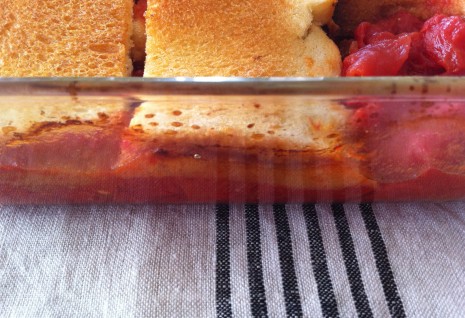SCALLOPED FRESH TOMATOES
The venerable American dish called scalloped (baked) tomatoes is closely identified with the South. But why? Surely it’s a no-brainer idea in any part of the country that experiences a barrage of juicy, ripe tomatoes in high summer.
I reached out to culinary historian and former Gourmet contributing editor Anne Mendelson. The origin of “scalloped” in the culinary sense is a murky subject best left for another day. As to the main ingredient, however, “Tomatoes grew better—getting sweeter and more flavorful—in the South than in the North until the end of the Little Ice Age, at around 1850,” she explained. “And for a long time after that, the New England growing season was too short for real summer tomato bounty.”
Perhaps that is why most recipes call for canned tomatoes, turning the dish into one of the world’s simplest, most economical year-round pantry sides. Its homey, enduring appeal has even made a splash in Manhattan; the “tomato pudding” on offer at Keedick Coulter’s Bobwhite Lunch & Supper Counter, on the Lower East Side, is as de rigueur as the impeccably fried chicken.
Irma Rombauer included a recipe for “Scalloped Tomatoes or Tomato Pudding” in the 1936 Joy of Cooking. “It consisted of a canned tomato purée and brown sugar mixture,” Mendelson said. “It was poured over one cup ‘fresh white bread crumbs’ and one-quarter cup melted butter and baked in a covered dish.”
In The Boston Cooking-School Cook Book (1896), the bestselling cookbook of the previous era, Fannie Farmer used canned tomatoes as well, sandwiching the contents of one can between layers of buttered cracker crumbs. But just 20-odd years earlier, Miss Leslie’s New Cook Book instructed readers to start with “fine large tomatoes, perfectly ripe,” and that is what I like to do this time of year, especially when I have a mixture of heirloom varieties on hand. When stewed, they give complexity and a good balance of acidity and fruity sweetness to the end result, and every time I make the dish, it tastes a little different.
Or very different, depending on what sort of mood I’m in. It’s easy to push scalloped tomatoes in an Italian direction by using olive oil instead of butter. Add chopped garlic to the onion in the pan and stir in some chopped fresh basil at the end of cooking. Then whizz up the bread into breadcrumbs and toss with more olive oil and Parmigiano-Reggiano for the topping. Or you could swing things over to Provence by adding garlic, a bay leaf, and a blend of finely chopped thyme, rosemary, and savory. Stir in a dab of anchovy paste or minced canned anchovy fillet while you’re at it. Here, too, breadcrumbs (or perhaps big irregular croutons) tossed in olive oil would be nice.
The following recipe is adapted from one in Gourmet called “Baked Tomatoes with Crusty Bread.” It appeared in the January 2008 issue along with a previously unpublished essay by Edna Lewis, one of our country’s most evocative food writers. In the headnote I wrote, “You will get enormous pleasure out of serving people this dish.” I still feel like that today. In fact, I can’t wait until my husband gets home and sees what is for supper.
Scalloped Fresh Tomatoes
Serves 4
Adapted from Gourmet and The Taste of Country Cooking, by Edna Lewis (Alfred A. Knopf, 1980)
If substituting canned tomatoes for fresh, you will need 2 large cans (about 28 ounces each) of them. Keedick Coulter’s family recipe specifies Hunt’s. I love that familiar taste as well, but please use your favorite brand. By the way, the brown sugar, common to many scalloped tomato recipes, isn’t meant to make the naturally sweet tomatoes any sweeter; it’s there to mellow their acidity (especially important if you are using canned) and add a little depth.
4 or 5 large soft-ripe fresh tomatoes (preferably a mix of heirloom varieties)
½ stick unsalted butter, softened, plus more for baking dish
1 medium onion, chopped
Coarse salt and freshly ground pepper
A pinch of ground allspice
½ teaspoon finely chopped fresh thyme leaves
½ tablespoon packed dark-brown sugar
4 slices white bread from a good-quality bakery loaf
1. To peel the tomatoes, drop them in a pot of boiling water. Turn off the burner and let them sit about 3 minutes. Drain the tomatoes in a colander and let them cool. Working over a sieve set over a bowl to catch the juices, pierce the skin of each tomato with a paring knife and slip off the skin.
2. Seed the tomatoes by first cutting them in half crosswise—around the equator—exposing the seed pockets. Use a finger to loosen the seeds in each pocket, then empty the tomato halves over the sieve. Roughly chop tomatoes (you should have 4 to 5 cups) and set aside, along with 1 cup juices.
2. Preheat oven to 425º and butter an 8-inch-square baking dish. Heat about 1 tablespoon butter in a pot over medium-high heat; add the onion and season with salt. Cook until the onion is golden-brown, about 10 minutes. Stir in the allspice and cook 1 minute. Add the tomatoes and juices, thyme, brown sugar, and a few grinds of pepper, and cook at a brisk simmer, stirring occasionally or shaking the pan to prevent the tomatoes from sticking, until thickened, about 20 minutes. You can stew the tomatoes ahead of time and set them aside to cool until needed.
3. Melt the remaining butter and brush onto both sides of the bread. Cut each slice into half. Ladle the tomato mixture into the baking dish and top with the bread slices, overlapping them. Bake until the tomatoes are bubbling and the bread is crisp and golden brown, about 20 minutes.
Posted: July 31st, 2012 under cookbooks, Gourmet magazine, people + places, recipes, summer.


